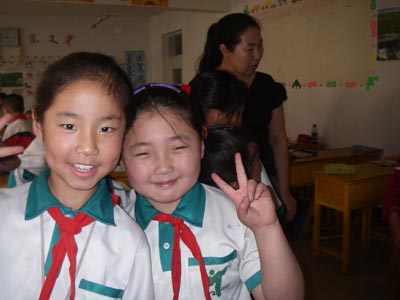"To keep a culture alive you must keep the language: if you lose
your language you will lose your culture," long ago stated Dr.
Edward T. Hall, a leading anthropologist from the United
States.
In Hohhot, Inner Mongolia, where I live, the language is
not only alive but flourishing. From primary school through
university, it is possible for anyone, not just a Mongolian, to
study the Mongolian language.
Currently three Mongolian-Chinese primary schools exist in
Hohhot, as well as several bi-lingual secondary schools. And all
the major universities have several double faculties?-- where
either Chinese or Mongolian is used to teach courses. Additionally
all these universities list university level Mongolian language
courses for any foreign students who wish major in the Mongolian
language. Finally, the Chinese government supports a Mongolian
School of the Arts where courses on Mongolian dancing, specialized
Mongolian singing techniques and traditional Mongolian instruments
are offered. Many of these graduates become professional
performers. Some graduates travel internationally and act as
representatives of Mongolian-Chinese culture.
 |
The Xing'an Road Minority Primary School has been open for six
years. The headmaster, Da Lu Du Ren, a jovial Mongolian man,
greeted me at the gate and said, "Welcome. We are the only primary
school in Hohhot that offers Mongolian, Chinese and Korean classes.
We have 82 staff members, 66 are teachers and many are renowned in
Hohhot and Inner Mongolia. We aim to provide an excellent
education."
 |
As he led me around, he explained that his school provides a
full academic curriculum in Mongolian and Chinese for 1,200
students, ranging in age from six to thirteen. The vast majority of
the students are locals, from full blood Mongolian families. "Only
a few of them, less than twenty, come from mixed marriages," he
remarked. "And there are a handful from families that just a little
Mongolian blood. But we have one student, a Buryat from the Russian
Federation, who has come as far away as St Petersburg to
specifically study Mongolian and Chinese. And right now we also
have some Korean nationals and some Outer Mongolians."
A few minutes later I walked around with a slender woman in her
thirties, a science teacher named Mu Lan as my guide. "Our school
has a large sports area, we teach Mongolian sports, such as
wrestling," she proudly said. "And we feed our children healthy
meals, here is the cafeteria."?Spacious and clean, filled with
rollicking students, the room had a nice feel to it. "Over a
hundred Outer Mongolian students live here at the school. We
provide them with room and board. Three Russian students also
attend our school, two from Ulan Ude. They both lives on campus but
the boy from St. Petersburg lives nearby with his family. Twelve
Korean students board here as well. They are all friendly toward
each other."
"Why do these foreign students come to your school?" I
queried.
"Because our educational system is superior to their countries,"
she replied. "And because their parents may be working here in
China, or their parents want their children to learn Chinese but
keep their own Mongolian language too. I have my son enrolled here
for those reasons."
"Do you think the Mongolian language will continue to survive?
In my country many minority languages have disappeared," I
commented.
"Yes, I most definitely think Mongolian language and culture
will survive. The Chinese government has passed laws encouraging
and supporting minority languages. Two years ago the government
made a law protecting the Mongolian language. And the Mongolian
people are a proud race. We will uphold our traditions, keep our
language, and enjoy our traditional foods. Now, would you like to
eat a little Mongolian lunch with me?" Mrs. Mu Lan asked. "The food
here is quite good."
"With pleasure," I replied, smiling.
(China.org.cn by Valerie Sartor, July 23, 2007)